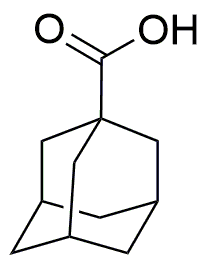1-Adamantanecarboxylic acid is widely utilized in research focused on:
- Pharmaceutical Development: This compound serves as a building block in the synthesis of various pharmaceuticals, particularly antiviral agents, enhancing drug efficacy.
- Polymer Chemistry: It is used to modify polymers, improving their thermal stability and mechanical properties, which is beneficial in creating durable materials for various applications.
- Organic Synthesis: Researchers employ it in organic reactions to produce complex molecules, streamlining the process of creating new compounds with desired properties.
- Material Science: The compound is explored for its potential in developing advanced materials, such as coatings and adhesives, due to its unique structural characteristics.
- Biochemical Research: It is utilized in studies related to enzyme inhibition and receptor binding, offering insights into biological processes and potential therapeutic targets.
General Information
Properties
Safety and Regulations
Applications
1-Adamantanecarboxylic acid is widely utilized in research focused on:
- Pharmaceutical Development: This compound serves as a building block in the synthesis of various pharmaceuticals, particularly antiviral agents, enhancing drug efficacy.
- Polymer Chemistry: It is used to modify polymers, improving their thermal stability and mechanical properties, which is beneficial in creating durable materials for various applications.
- Organic Synthesis: Researchers employ it in organic reactions to produce complex molecules, streamlining the process of creating new compounds with desired properties.
- Material Science: The compound is explored for its potential in developing advanced materials, such as coatings and adhesives, due to its unique structural characteristics.
- Biochemical Research: It is utilized in studies related to enzyme inhibition and receptor binding, offering insights into biological processes and potential therapeutic targets.
Documents
Safety Data Sheets (SDS)
The SDS provides comprehensive safety information on handling, storage, and disposal of the product.
Product Specification (PS)
The PS provides a comprehensive breakdown of the product’s properties, including chemical composition, physical state, purity, and storage requirements. It also details acceptable quality ranges and the product's intended applications.
Certificates of Analysis (COA)
Search for Certificates of Analysis (COA) by entering the products Lot Number. Lot and Batch Numbers can be found on a product’s label following the words ‘Lot’ or ‘Batch’.
*Catalog Number
*Lot Number
Certificates Of Origin (COO)
This COO confirms the country where the product was manufactured, and also details the materials and components used in it and whether it is derived from natural, synthetic, or other specific sources. This certificate may be required for customs, trade, and regulatory compliance.
*Catalog Number
*Lot Number
Safety Data Sheets (SDS)
The SDS provides comprehensive safety information on handling, storage, and disposal of the product.
DownloadProduct Specification (PS)
The PS provides a comprehensive breakdown of the product’s properties, including chemical composition, physical state, purity, and storage requirements. It also details acceptable quality ranges and the product's intended applications.
DownloadCertificates of Analysis (COA)
Search for Certificates of Analysis (COA) by entering the products Lot Number. Lot and Batch Numbers can be found on a product’s label following the words ‘Lot’ or ‘Batch’.
*Catalog Number
*Lot Number
Certificates Of Origin (COO)
This COO confirms the country where the product was manufactured, and also details the materials and components used in it and whether it is derived from natural, synthetic, or other specific sources. This certificate may be required for customs, trade, and regulatory compliance.


